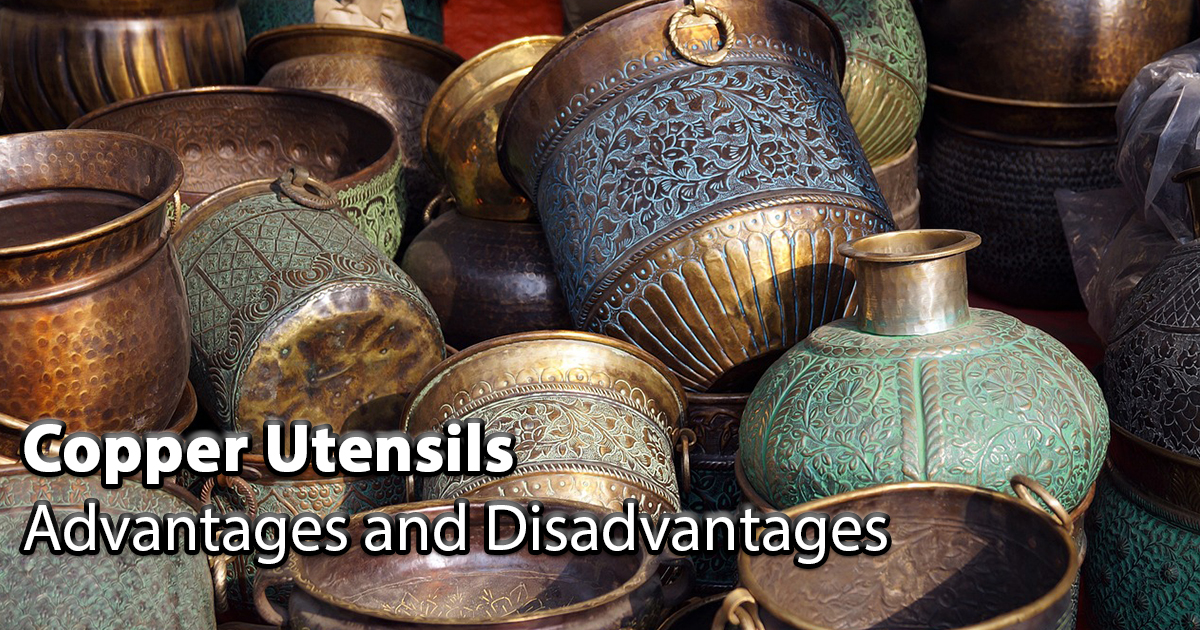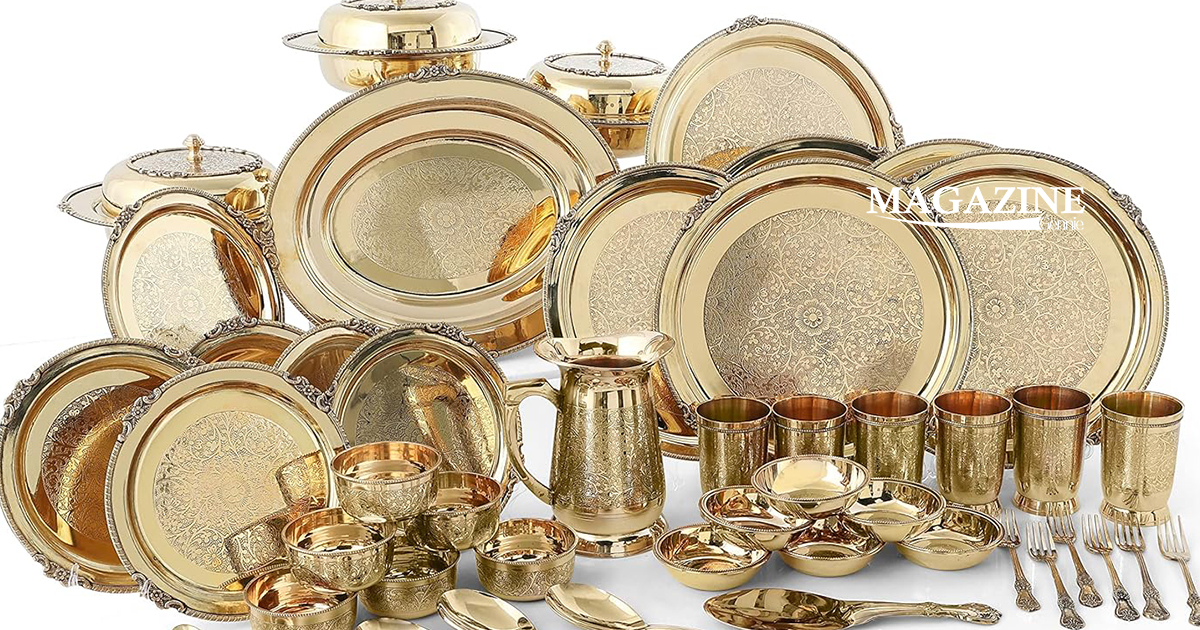Copper utensils have a rich history in the culinary world, known for their exceptional heat conductivity and unique properties. Whether you’re a professional chef or a home cook, the allure of copper cookware is undeniable. In this comprehensive guide, we will delve into the world of copper utensils, exploring their advantages and potential drawbacks in detail. From enhancing flavor to their maintenance requirements, this article will provide you with insights to make informed choices about using copper utensils in your kitchen.
Table of Contents
Introduction
Copper utensils have graced kitchens for centuries, known for their unique properties that offer a delightful cooking experience. While they have their advantages, it’s essential to understand the potential drawbacks to make an informed choice about incorporating copper utensils into your culinary repertoire.
Advantages of Copper Utensils for Food
1. Exceptional Heat Conductivity
Copper is renowned for its outstanding heat conductivity. It heats up quickly and evenly, ensuring that food cooks consistently. This rapid heat transfer is invaluable for searing, sautéing,
level of control is particularly advantageous for delicate dishes that require careful temperature management, such as sauces and candies.
3. Enhanced Flavor
Cooking in copper utensils can impart a distinct and subtle flavor to the food. The ions released from copper interact with ingredients, enhancing the overall culinary experience. Many chefs appreciate this unique feature, especially when preparing traditional and time-tested recipes.
4. Even Heat Distribution
Copper utensils distribute heat evenly across their surfaces, preventing hotspots and ensuring uniform cooking. This even heat distribution is ideal for achieving consistent results, whether you’re searing a steak or simmering a delicate sauce.
5. Aesthetic Appeal
Copper utensils add a touch of elegance to any kitchen. Their warm, reddish-gold hue and classic design make them not only functional but also decorative. Copper cookware can transform your kitchen into a culinary haven, adding visual appeal to your cooking space.
Disadvantages of Copper Utensils for Food
1. Reactivity with Certain Foods
Copper has a natural tendency to react with acidic foods, such as tomatoes or citrus fruits. This reactivity can cause a metallic taste in dishes, which may be undesirable. To prevent this, copper utensils are typically lined with a layer of stainless steel or tin.
2. Maintenance and Polishing
Copper cookware requires regular maintenance to keep it in optimal condition. Over time, it can develop a patina, affecting its appearance. Polishing is necessary to restore its original shine, which may be a time-consuming task for some.
3. Initial Cost
High-quality copper utensils can be relatively expensive compared to alternative materials like stainless steel or non-stick cookware. The initial cost can be a barrier for some individuals, especially those on a tight budget.
4. Weight
Copper utensils tend to be heavier than some other materials, which can pose a challenge for individuals who have difficulty handling weighty cookware. The added weight can make them less practical for some users.
5. Limited Variety
The variety of copper utensils available in the market is not as extensive as that of materials like stainless steel or non-stick cookware. This can limit your options for specific cookware needs and styles.
How to Use and Maintain Copper Utensils
To make the most of your copper utensils while mitigating potential disadvantages, consider the following tips:
- Lining: If possible, choose copper utensils that are lined with stainless steel or tin to prevent reactivity with acidic foods.
- Maintenance: Incorporate a regular cleaning and polishing routine to keep your copper cookware in top condition. Use a mixture of salt and lemon juice to clean and restore its shine.
- Balanced Use: While copper cookware offers exceptional benefits, balance its use with other types of cookware in your kitchen. Use it for dishes that won’t react with copper, and rely on alternative cookware for acidic recipes.
- Dry Thoroughly: After washing, dry your copper utensils thoroughly to prevent water spots and maintain their appearance.
Conclusion
In conclusion, copper utensils offer a unique cooking experience with several advantages, such as exceptional heat conductivity, precise temperature control, and enhanced flavor. However, they also come with potential disadvantages, including reactivity with certain foods, maintenance requirements, and initial cost.
Whether copper utensils are suitable for your kitchen ultimately depends on your personal preferences, cooking style, and willingness to maintain and care for these classic yet timeless pieces of cookware. While they may require extra care, the advantages of using copper cookware often outweigh the disadvantages for those who appreciate the unique qualities they bring to the art of cooking.
Copper utensils hold a special place in kitchens around the world,and understanding their advantages and disadvantages empowers you to make an informed choice. Whether you embrace them for their exceptional heat conductivity, precise temperature control, and aesthetic appeal, or opt for alternatives, the world of culinary exploration is vast and diverse.
With the right knowledge and care, copper utensils can be a treasured addition to your kitchen, contributing to memorable meals and a touch of timeless elegance.
Copper utensils have a place in the culinary history of many cultures, and their timeless charm continues to inspire and elevate the art of cooking.
Related : Advantages and Disadvantages of Brass Utensils for Food: A Comprehensive Guide
The Timeless Charm of Copper Utensils
Copper utensils have been a culinary companion for generations, and their charm continues to captivate both professional chefs and passionate home cooks. As we conclude our exploration of copper utensils, let’s reflect on the timeless allure they bring to our kitchens.
A Link to Culinary Heritage
The presence of copper utensils in our kitchens is a connection to our culinary heritage and ancestral knowledge. They remind us of the wisdom and traditions passed down through generations, where our ancestors valued the unique properties of copper in the kitchen. Using these utensils is a way of honoring the culinary legacy that has been shaped by the hands of countless chefs and home cooks before us.
The Transformation of Dishes
Copper utensils have a magical quality that can transform ordinary ingredients into extraordinary dishes. The rapid and even heat distribution they offer makes each meal a journey through time and tradition. These utensils have witnessed countless family gatherings, celebrations, and everyday meals, all elevated by their unique qualities.
A Touch of Elegance
Copper utensils add a touch of elegance and warmth to our kitchens. Their lustrous, reddish-golden sheen and classic design make them not just functional but also a decorative element. They can transform even the most modest kitchen into a space that exudes culinary sophistication.
Sustainability and Responsibility
In a world increasingly focused on sustainability and responsible choices, copper utensils stand out. Their durability and longevity reduce the need for constant replacements, contributing to a more eco-friendly kitchen. By choosing to cook with copper, we make a small but meaningful commitment to reducing waste and environmental impact.
The Joy of Culinary Exploration
Copper utensils invite us to explore the depths of culinary artistry. They encourage us to experiment with flavors, textures, and techniques, providing a canvas upon which to create exceptional dishes. The journey of cooking with copper is a celebration of culinary craftsmanship and a homage to the art of gastronomy.
Timelessness and Beauty
The timeless beauty of copper utensils transcends culinary functionality. Their warmth and elegance add a sense of grace and beauty to our kitchens. They are not just cookware; they are also objects of art, transforming our culinary spaces into places of inspiration.
Final Thoughts
As we conclude our exploration of the timeless charm of copper utensils, remember that the allure of these classic pieces of cookware extends beyond their functionality. It lies in the experiences, traditions, and stories they bring to your kitchen. Copper utensils have a special place in the hearts of those who appreciate the art and science of cooking and continue to shine as valuable treasures in the world of culinary craftsmanship.
Whether you are a seasoned chef or an enthusiastic home cook, don’t hesitate to embrace the tradition and advantages of copper utensils in your kitchen. They are not just utensils; they are gateways to a world of culinary exploration, tradition, and timelessness. Embrace the charm of copper utensils, and let them be a part of your culinary journey.
Tips for Using Copper Utensils
To make the most of your copper utensils and ensure they continue to shine in your kitchen, consider the following tips:
- Choose Lined Copper Utensils: If possible, select copper cookware that is lined with stainless steel or tin. This lining acts as a barrier, preventing the copper from reacting with acidic foods and compromising the flavor of your dishes.
- Regular Cleaning and Polishing: Incorporate a regular cleaning and polishing routine to maintain the shine and appearance of your copper utensils. Over time, copper develops a patina, affecting its brightness. To restore its original shine, use a mixture of salt and lemon juice to gently clean and polish the surface. Alternatively, you can use specialized copper cleaning products.
- Balanced Use: While copper cookware offers exceptional advantages, balance its use with other types of cookware in your kitchen. Save your copper utensils for dishes that won’t react with copper, such as frying, sautéing, and simmering. Use alternative cookware like stainless steel or non-stick pans for recipes that contain acidic ingredients, such as tomatoes or citrus fruits.
- Dry Thoroughly: After washing your copper utensils, be sure to dry them thoroughly with a clean, dry cloth. This helps prevent water spots and maintains the appearance of your cookware.
- Store Carefully: When not in use, store your copper utensils in a dry, cool place. Avoid stacking them, as contact with other utensils can lead to scratches or damage. Consider hanging them on a pot rack or using individual padded storage to keep them in top condition.
By following these tips and caring for your copper utensils, you can enjoy their timeless charm and exceptional culinary benefits while ensuring they remain in excellent condition for years to come. Copper utensils are not just functional tools; they are a symbol of culinary tradition and craftsmanship, adding a touch of elegance and artistry to your kitchen.
How to Use and Maintain Copper Utensils
Copper utensils, known for their exceptional heat conductivity and unique properties, can be a valuable addition to your kitchen. To make the most of your copper cookware while ensuring their longevity and performance, consider the following tips on how to use and maintain copper utensils:
- Choose Lined Copper Utensils: When selecting copper cookware, opt for pieces that have a lining of stainless steel or tin. This lining serves as a protective barrier, preventing the copper from reacting with acidic foods. This is particularly crucial when working with recipes that contain ingredients like tomatoes or citrus fruits, which can cause a metallic taste when in contact with pure copper.
- Season Your Copper Cookware: Just like cast iron, copper cookware can benefit from seasoning. To season your copper utensils, follow these steps:
- Wash the utensil with warm, soapy water to remove any dust or residue.
- Rinse the utensil thoroughly and dry it with a clean, dry cloth.
- Apply a thin layer of vegetable oil or a specialized copper paste to the interior of the utensil.
- Heat the utensil over low to medium heat for several minutes to allow the oil or paste to penetrate and create a protective layer.
- Let the utensil cool, then wipe away any excess oil or paste. Your copper cookware is now seasoned and ready for use.
- Balanced Use: While copper cookware offers exceptional benefits, it’s advisable to balance its use with other types of cookware in your kitchen. Use copper utensils for dishes that won’t react with copper, such as frying, sautéing, and simmering. For recipes containing acidic ingredients, opt for alternative cookware like stainless steel or non-stick pans to prevent potential reactivity.
- Regular Cleaning and Polishing: Copper cookware requires regular cleaning to keep it in top condition. Use a mixture of salt and lemon juice or a specialized copper cleaner to gently scrub the surface. This helps remove tarnish and restore the original shine. After cleaning, rinse the utensil with warm water, dry it thoroughly with a clean, dry cloth, and store it properly.
- Dry Thoroughly: After washing your copper utensils, it’s essential to dry them thoroughly. This prevents water spots and maintains the bright appearance of the cookware. Moisture left on the copper surface can lead to tarnishing, so be diligent about drying after each use.
- Store Carefully: When storing your copper utensils, avoid stacking them, as contact with other utensils can result in scratches or damage. Consider hanging your cookware on a pot rack or using individual padded storage to ensure they are stored safely.
By following these guidelines for using and maintaining your copper utensils, you can enjoy the exceptional cooking properties and aesthetic appeal of copper cookware while ensuring they remain in excellent condition. Copper utensils are not just functional tools; they are a symbol of culinary tradition and craftsmanship, adding a touch of elegance and artistry to your kitchen.
The Future of Copper Utensils in Modern Kitchens
Copper utensils have a rich history and timeless charm, but what does the future hold for them in modern kitchens? In a world of ever-evolving culinary traditions and technological advancements, copper utensils continue to hold a special place. Let’s explore the role and prospects of copper utensils in contemporary and future kitchens.
Copper Utensils in Modern Kitchens
In an era where stainless steel, non-stick, and other modern cookware materials dominate the market, copper utensils have found a place. Here’s why they are being embraced by chefs and home cooks in modern kitchens:
1. Unique Cooking Properties
Copper is renowned for its exceptional heat conductivity. This quality makes it an excellent choice for chefs seeking precise temperature control and even heat distribution. These properties are particularly crucial in professional kitchens where consistent cooking results are paramount.
2. Flavor Enhancement
In the quest for culinary excellence, modern chefs and home cooks are recognizing the distinct flavor enhancement that cooking in copper utensils can bring. Whether it’s a perfectly seared steak, a well-spiced curry, or a slow-cooked stew, the subtle notes imparted by copper are gaining favor.
3. Aesthetic Appeal
Copper utensils bring a touch of elegance and vintage charm to modern kitchens. Their reddish-gold hue and intricate designs add an aesthetic element that enhances the overall kitchen ambiance. Many find them visually appealing and a conversation starter in their culinary spaces.
4. Sustainability
In a world increasingly focused on sustainability and eco-friendly practices, copper utensils align with the ideals of reducing waste and minimizing environmental impact. Their durability and longevity reduce the need for frequent replacements, making them a responsible choice for environmentally conscious individuals.
5. Versatility
While traditionally associated with specific types of cuisine, copper utensils have shown their versatility. They can be used for a wide range of recipes, both traditional and modern, demonstrating their adaptability in today’s diverse culinary landscape.
Tips for Using Copper Utensils in Modern Kitchens
To make the most of copper utensils in a modern kitchen, consider the following tips:
- Experiment with Recipes: Don’t limit yourself to traditional dishes. Copper utensils can be used for a variety of recipes, from stir-fries to baking. Explore and experiment to discover their full potential.
- Maintenance Routine: Incorporate regular cleaning and seasoning into your kitchen routine. By maintaining your copper utensils, you can preserve their appearance and performance.
- Balanced Use: While copper utensils have unique properties, balance their use with other cookware in your kitchen to avoid potential reactivity with highly acidic foods.
- Culinary Decor: Use copper utensils as decorative pieces when not in use. Display them in your kitchen to add a touch of vintage charm and create a stunning culinary atmosphere.
Conclusion
The future of copper utensils in modern kitchens is bright, and their resurgence is a testament to their enduring value. They offer a unique cooking experience that can’t be replicated by other materials, adding a touch of tradition and elegance to contemporary culinary spaces.
The advantages of using copper utensils, from flavor enhancement to sustainability, make them a valuable addition to any kitchen, whether you’re a professional chef looking for precise control or a home cook seeking to elevate your culinary creations.
In an age of culinary innovation, copper utensils bridge the gap between tradition and modernity, providing an opportunity to explore the rich history of culinary craftsmanship while embracing the future of cooking.
Copper utensils, with their timeless charm and unique cooking properties, continue to hold a special place in the hearts of those who appreciate the art and science of cooking. As you consider your kitchen equipment, keep in mind that the allure of copper utensils extends far beyond their appearance; it lies in the transformative experiences they bring to your culinary creations.
As we look ahead, the future of copper utensils in modern kitchens remains promising, a testament to their enduring appeal and their ability to create exceptional culinary experiences.




